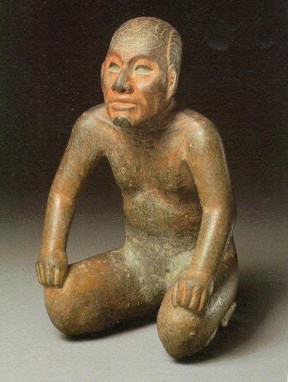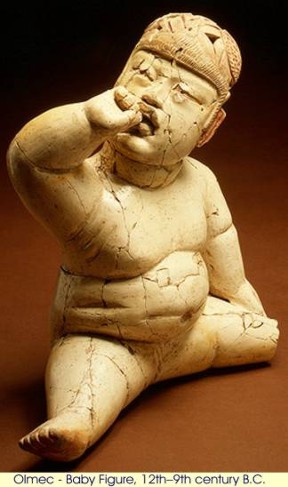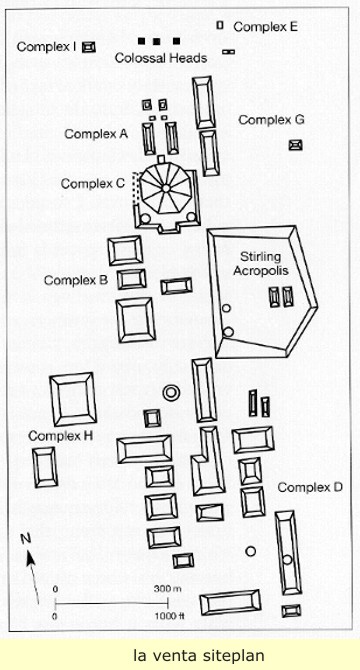
In the Americas, we are now learning that the history of the Americas is much older, and much more complicated than was once thought.
New evidences of early human habitation are constantly being found, a few sites have produced dates of human habitation as early as 50,000 years ago and more. Sites such as Pedra Furada - Brazil, Monte Verde - Chile, and Fells cave in Tierra del Fuego - Chile, are enabling us to paint a new, and more complete picture, of the early history of the Western Hemisphere.
 |
From information gathered so-far at these sites has come the following chronology of mans presence in the Americas.
 From Unknown-maybe 50,000 to 20,000 B.C. Australoids (people from Australia) were coming in. These Australians (commonly called aborigines), have been in Australia for 66,000 years.
From Unknown-maybe 50,000 to 20,000 B.C. Australoids (people from Australia) were coming in. These Australians (commonly called aborigines), have been in Australia for 66,000 years.
The photo left, is of the Australian female nicknamed "Luzia", her almost complete skeleton, which bears the scientific name of Lapa Vermelha IV Hominid 1, was unearthed in 1974-75 in the Lagoa Santa region, in the state of Minas Gerais, Brazil. It is about 12,000 years old.
20,000 to 7,000 B.C. – Polynesians were coming in.
| Note: Polynesian is a term that the Albino people have applied to Pacificans/Austronesians who have significant "White Mongol/European" admixture. They reserve the term Melanesian for the original "Pure Black" Pacificans/Austronesians who have resisted admixture. |
A note here: It seems highly unlikely that early Australoids could have crossed the vast expanse of the Pacific in boats that long ago. Perhaps a better theory is that they used a route around the Antarctic, just as the Amerindian used a route around the Arctic.
12,000 - 7,000 B.C. (the Clovis time-frame) – Mongol Amerindians were coming in across the Bering Straits, with the Eskimo being the last of these migrants.
A curiosity concerning population patterns in the Americas: By the time of the Europeans, the estimated population of the Americas was 100 million. With 40 million in the densely populated area of Mexico and Central America, 45 million in South America. But, only 10 million in the vast expanse of Canada and the United States. This was the source of much head-scratching, until a clever theory was put forth - one that does have some evidence.
The theory is, that at the time of the Clovis migration, much of North America was still covered in Glacial Ice, so instead of walking south, the Amerindian "Island-Hopped" south in boats, using coastal islands (which are known to have been icefree) and icefree patches of coastline, until they found habitable land. Seems to be a perfectly reasonable theory.
Then again, could it be much simpler: keeping in mind that the Amerindian, like the other people of the Eurasian plains, were hunter-gathering nomads. Could it be that there was originally a much larger population in the United States, and perhaps these people saw the cities and agricultural abundance of the south as candidates for looting and plundering. And perhaps after having gone south, and plundered and looted, they also saw the advantages of that lifestyle and stayed. This scenario would seem to explain the Aztec presence, the very high population density in Mesoamerica, and the lack of large scale building in North America - Mexico excluded.
For a more in-depth study of the Peopling of the Americas <<Click Here>>
 |
Quote from the study above: Here we analyse genome-wide data to show that some Amazonian Native Americans descend partly from a Native American founding population that carried ancestry more closely related to indigenous Australians, New Guineans and Andaman Islanders than to any present-day Eurasians or Native Americans.
BELOW IS WHAT THE FIRST AMERICANS LOOKED LIKE! |
 |
 |
 |
"Genetic evidence for two founding populations of the Americas".
http://www.nature.com/nature/journal/vnfv/ncurrent/full/nature14895.html
The Olmec were the first civilization in the Americas {Not the first people}. When they arrived is not known, but a guess of 8,000-4000 B.C. should do. Recent research suggests that the Olmec had their roots in early farming cultures of Tabasco, which began between 5100 BCE and 4600 BCE. These shared the same basic food crops and technologies of the later Olmec civilization. The Olmec culture is thought to have ended around 400 B.C. These Olmec inhabited southern Mexico, and are regarded as the Mother Culture of the Americas – that is to say, the later Amerindian cultures and technology of the Americas, descend from Olmec culture and technology.
The name Olmec means "rubber people" in Nahuatl, the Aztec language. It was the Aztec name for the people who once lived in this area, and extracted latex from rubber trees. Europeans mistakenly assigned the name to ancient ruins that they found there, not realizing that those ruins pre-dated the Aztec and all other civilizations in the Americas. The word "Olmec" also refers to the rubber balls, used for the ancient ball game of Olmec creation. The Olmec called themselves the Xi, the same name that they used when they were in China. They often depicted themselves with colossal heads, some of which were deformed, and whose meaning is unknown.
 |
When evidence of the Olmec was first discovered (in 1863), scientists at first didn't know what to make of them. The questions were, where did they come from, and how did they get here? It was first thought that the Olmec were west Africans, who had came across in boats. But now there is mounting evidence that the Olmec were remnants from the Xia dynasty of China, who probably had come across the Bering straits into the Americas.


 |
What may be evidence of their trek south, along the western north-American coast, can be seen in the masks of the Tsimshian Indians of the western coast of Canada, and in written accounts of the California Indians in The United States. There is also the similarity between Xia Human sacrifice in China, and Olmec human sacrifice in the Americas, as well as their fondness for jade work. The last and most recent evidence: comparison of Shang writing in China, and Olmec writing in America, show the two to be very similar. Of course, we won't even mention that they still called themselves the Xi or Xia.


The Olmec were like the other Ancients, a highly advanced culture. They had writing, mathematics, and a calendar system. Their religion was Shamanism - the supposed ability to assume the powers of animals.


 |
 |
Olmec cities had ceremonial buildings or temples, that were typically earthen platform mounds, with house-like structures built upon them. At La Venta we can see such platform mounds arranged around large plazas as well as a tall pyramid. Olmec cities also had aqueducts and drainage systems.
 |
 |
The Olmec introduced many things to the Americas, most of them good. However, the Xia/Olmec practice of Human sacrifice, which even intruded unto another Olmec invention, The Rubber Ball Game, was not. And there is no doubt, that the Amerindians wholehearted acceptance and subsequent practice of human sacrifice, was the major contributor to their demise. The hatreds that built-up because the strong were using the weak as pools of sacrificial candidates, meant that they would do exactly as they did do, when the occasion arose.
Now that "almost" everyone has been introduced, lets go back to Sumer.
Please visit the "Additional Material Area" for many more photographs of each civilization, and related material <Click> |
| < Back | Home | Next > |